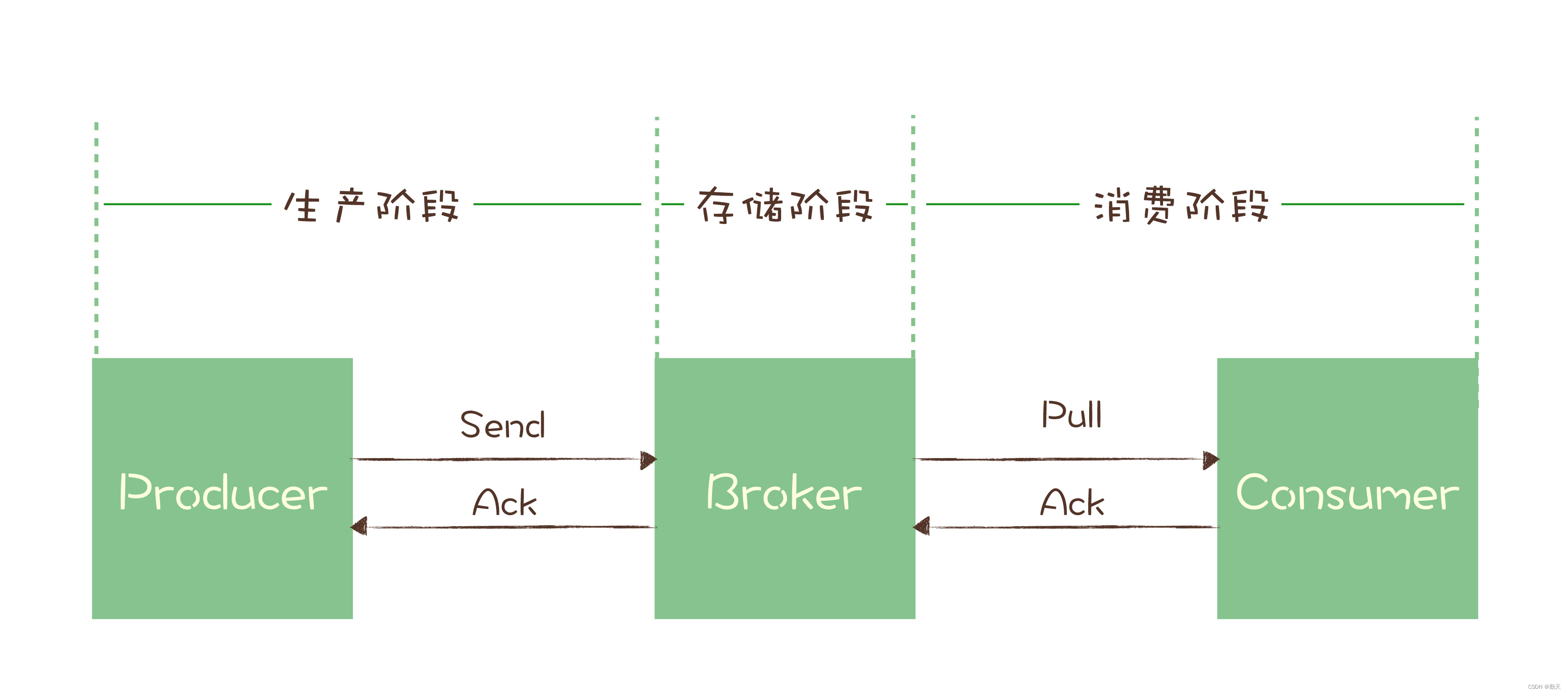author : Where to stay & Bobby
OpenSergo What is it?
In the traditional microservice Architecture , We divide the roles in service invocation into four parts : Service providers 、 Serving consumers 、 Registry Center 、 monitor . With the continuous evolution of distributed service architecture, there are many complex stability and ease of use problems , Single monitoring can no longer meet the evolution of the architecture . In the modern microservice Architecture , We need some means to deal with the complex microservice architecture “ government ”. Microservice governance is through full link grayscale 、 Lossless online and offline 、 Flow control degradation 、 Abnormal traffic scheduling 、 Database governance and other technical means to reduce or even avoid the stability problems encountered in the process of publishing and managing large-scale applications , Manage the components in the field of microservices . Service providers 、 consumer 、 Registry Center 、 Service governance , It constitutes several important links in modern microservice architecture .

Within the enterprise , There are often different languages 、 Microservices with different communication protocols , This isomerized architecture will lead to the process of governing micro Services , Business Developer 、 Architects cannot govern and control all services in a unified way , And this kind of isomerism will generate more pain points :
The industry has no clear understanding of the capabilities and boundaries of service governance , The concept of service governance defined by each enterprise is inconsistent , Resulting in high understanding and communication costs .
There are many open source microservice frameworks , Lack of some standardized conventions on service governance . for example ,Spring Cloud Microservice interfaces and interfaces defined in Dubbo There is no way for the interfaces defined in to communicate with each other , adopt Dubbo and Istio There is no way to manage the managed microservices in a unified way . Developers cannot configure different frameworks in a unified way 、 Unified management and control of services in different languages .
Lack of real business orientation 、 Abstractions and standards that can reduce the burden of cognition . What developers really want may be simple 、 Specify the calling relationship and configuration rules between services . But now for business developers , It is not only necessary to understand the deployment architecture of different microservice frameworks , We should also understand the concepts and capabilities of different service governance methods , The cognitive cost is great .
Based on the above pain points , Alibaba is in 2022 year 1 The month begins with bilibili、 Vendors such as byte discuss how to standardize and popularize service governance , Thus co sponsored OpenSergo project .OpenSergo It's a set of openness 、 General purpose 、 Distributed service oriented architecture 、 Service governance standards covering the whole link isomerization ecosystem , Form a general standard for service governance based on the service governance scenarios and practices in the industry .
OpenSergo The most important feature of the game is
With a unified set of configurations /DSL/ The agreement defines the service governance rules , Multilingual isomerization oriented architecture , Achieve full link ecological coverage .
No matter the language of microservices is Java, Go, Node.js Or other languages , Whether it's standard microservices or Mesh Access , From gateway to microservice , From database to cache , From service registration discovery to configuration , Developers can use the same OpenSergo CRD The standard configuration provides unified governance and control for each layer , Instead of focusing on the frameworks 、 Differences in language , Reduce isomerization 、 The complexity of full link service governance and control .
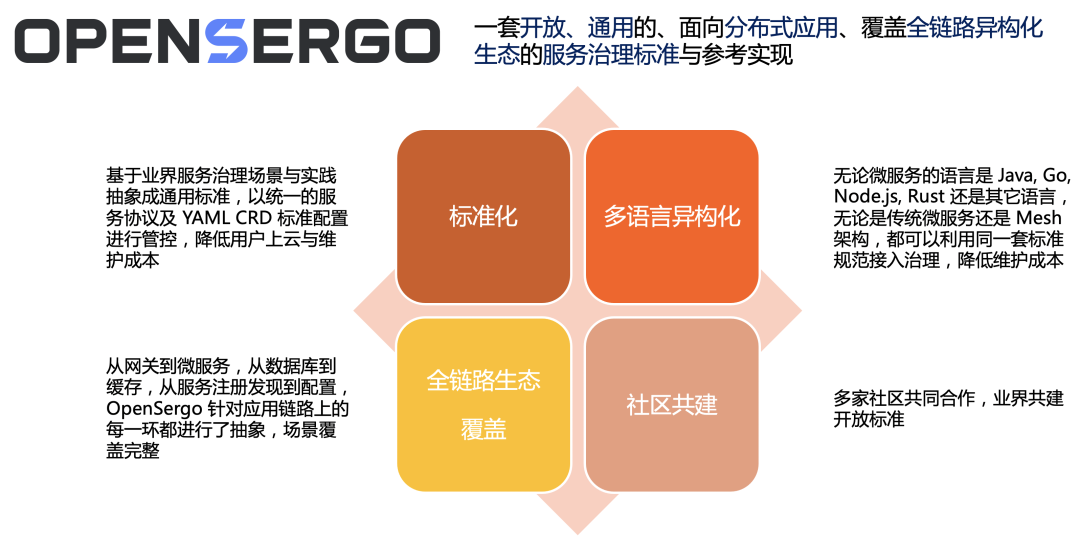
OpenSergo The standard is based on the practice and scenario abstraction of related fields in microservice governance , It covers the service meta information 、 Traffic management 、 Service fault tolerance 、 database / Cache governance 、 Service registration found 、 Configuration governance and other key areas , It covers the complete life cycle of microservices ( From development state to test state , To release , And then to the running state ). Whether we want to target Spring Cloud + Dubbo Service link configuration traffic gray isolation , I still hope for one Go gRPC Service flow control , I still hope that the database access for the service is slow SQL Call to automatically fuse , We can all use OpenSergo spec As defined in CRD Standard for unified configuration , There is no need to pay attention to the different declarative expressions of each framework API And incompatible configuration formats .
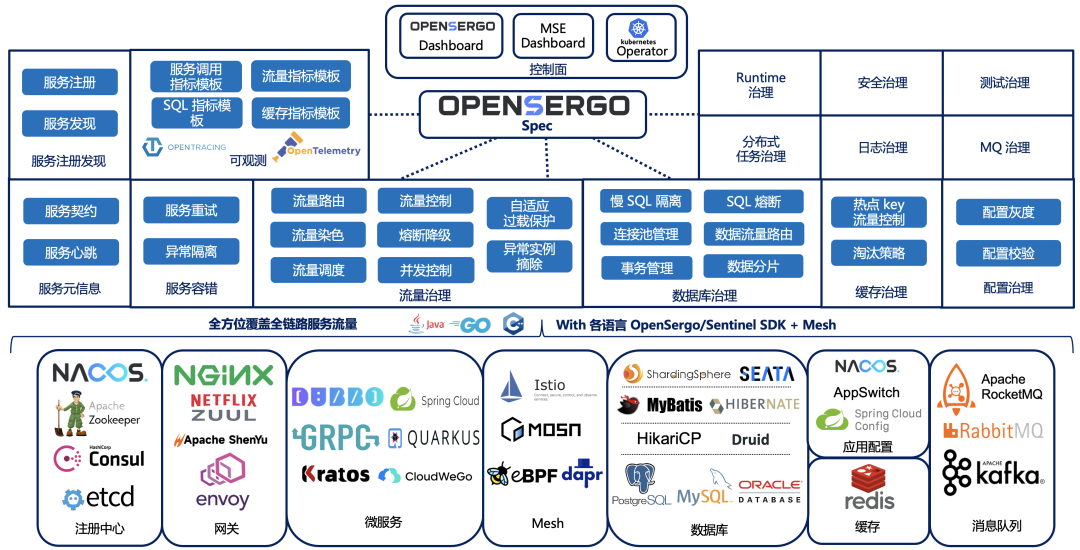
OpenSergo Ecology consists of the following parts :
We look forward to working with all communities to build , Connect more frameworks and components to OpenSergo In the ecological , Every framework is OpenSergo The data side of , Can pass OpenSergo CRD Conduct unified management and control .
that OpenSergo What exactly does the standard look like ? We can use OpenSergo What are the standards to do ? Let's introduce it with several examples .
OpenSergo Standard introduction
OpenSergo The project covers service meta information 、 Service registration found 、 Traffic management 、 Service fault tolerance 、 Database governance 、 Cache management and other fields . In our first version v1alpha1 In the version , We provide Service contract ( Metadata )、 Traffic routing 、 Flow control degradation In these areas CRD standard . Next, let's introduce the examples of traffic routing and flow control degradation .
Traffic routing
Traffic routing , As the name suggests, it refers to the traffic with certain attribute characteristics , Route to the specified destination . Traffic routing is an important part of traffic management , We can implement various scenarios based on traffic routing Standards , Such as full link gray 、 Release of canary 、 Disaster tolerant routing .
Traffic routing rules (v1alpha1) It is divided into three parts :
Workload Labeling rules (WorkloadLabelRule): Put a group workload( Such as Kubernetes Deployment, Statefulset Or a group pod, Or some JVM process , Even a group DB example ) Label it accordingly
We take the widely used full link grayscale scene as an example . The full link grayscale passes through a series of traffic routing rules , Divide the same version of multiple services on the link into the same swimlane , So as to restrict the flow to flow only in the specified Lane , Realize the purpose of traffic isolation of the whole link .
The whole process can be summarized in the following figure , We use general Workload Labeling rules and flow labeling rules , To realize the gray scale capability of the complete service link in a unified standard way .
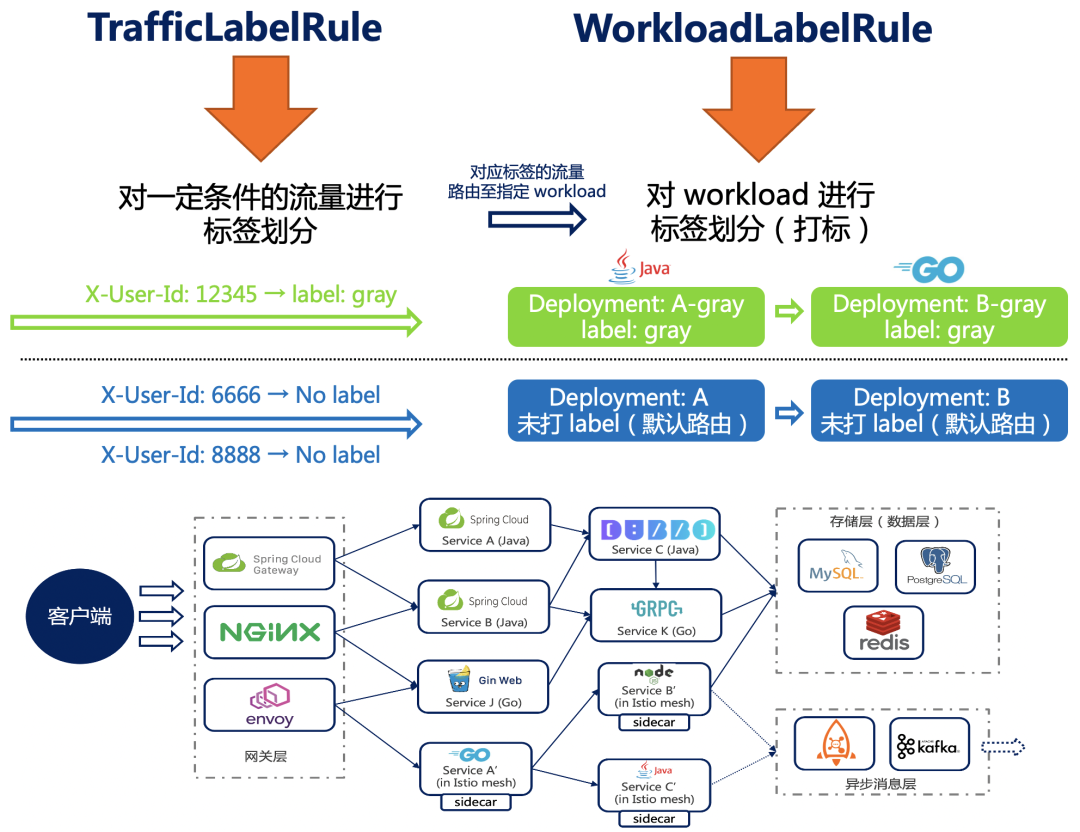
to Workload tagging :
When we gray the new version , Usually there will be a separate environment , Separate deployment sets . We put a separate deployment set gray label ( The tag value can be customized ), Tags will participate in specific traffic routing .
We can do it directly in Kubernetes workload Hit up label Tag binding , If in Deployment Put it on traffic.opensergo.io/label: gray Labels represent grayscale . For some complex workload Marking scene ( Such as database instance 、 Cache instance tags ), We can use WorkloadLabelRule CRD To mark . Example :
apiVersion: traffic.opensergo.io/v1alpha1
kind: WorkloadLabelRule
metadata:
name: gray-sts-label-rule
spec:
workloadLabels: ['gray']
selector:
app: my-app-gray
database: 'foo_db'
Mark the flow :
Suppose you now need to gray the internal test users to the new homepage , Test user uid=12345,UID be located X-User-Id header in , Then you only need to configure the following CRD that will do :
apiVersion: traffic.opensergo.io/v1alpha1
kind: TrafficLabelRule
metadata:
name: my-traffic-label-rule
labels:
app: my-app
spec:
selector:
app: my-app
trafficLabel: gray
match:
- condition: "==" # Match expression
type: header # Match attribute types
key: 'X-User-Id' # Parameter name
value: 12345 # Parameter values
- condition: "=="
value: "/index"
type: path
Through the above configuration , We can path by /index, And uid header by 12345 Of HTTP Traffic , In the play gray mark , It means that this traffic is gray traffic .
Route by tag :
In the specific routing process , Access OpenSergo The microservice framework of 、Service Mesh Of proxy in , As long as it's done OpenSergo Standard and configure the above rules , Then you can identify the labels and workload The label of . belt gray The flow of tags will flow to gray In the instance group of the tag ; If there is no in the cluster gray Instance grouping ( That is, no workload With this label ), By default fallback To instances without labels . Subsequent versions of the standard will provide a way to configure unmatched traffic .
The community is also constantly improving the standards related to traffic routing , And cooperate with various communities to build , Let more framework components support OpenSergo standard , So as to support unified traffic routing control .
Flow control degradation and fault tolerance
Flow control degradation and fault tolerance are also the key links in service traffic management , Take flow as the starting point , Through flow control 、 Fusing the drop 、 The flow is smooth 、 Adaptive overload protection and other means to ensure the stability of the service . stay OpenSergo in , We combine Sentinel And other frameworks to practice the flow control degradation and fault-tolerant extraction Standards CRD. A fault tolerant governance rule (FaultToleranceRule) It consists of three parts :
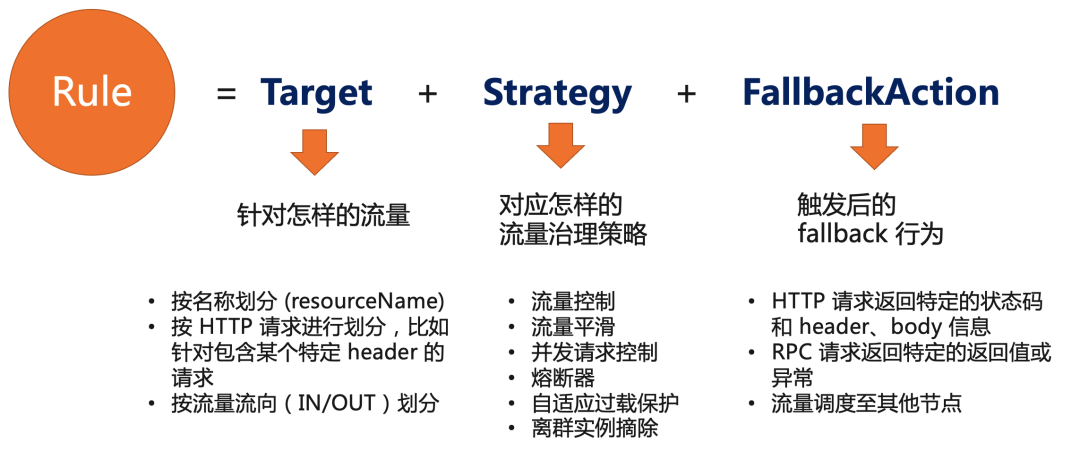
Whether it's Java still Go still Mesh service , Whether it's HTTP Request or RPC call , Or database SQL visit , We can all use this unified fault-tolerant governance rule CRD To configure fault-tolerant governance for each ring in the microservice architecture , To ensure the stability of our service link . As long as the microservice framework is adapted OpenSergo, Through unification CRD Flow control degradation and other governance .
following YAML CR The rules defined in the example are for path by /foo Of HTTP request ( Identify with resource name ) A flow control strategy is configured , The overall situation does not exceed 10 QPS. When the policy is triggered , The rejected request will be based on the configured fallback return 429 Status code , The return information is Blocked by Sentinel, At the same time return to header Add one header,key by X-Sentinel-Limit, value by foo.
apiVersion: fault-tolerance.opensergo.io/v1alpha1
kind: RateLimitStrategy
metadata:
name: rate-limit-foo
spec:
metricType: RequestAmount
limitMode: Global
threshold: 10
statDuration: "1s"
---
apiVersion: fault-tolerance.opensergo.io/v1alpha1
kind: HttpRequestFallbackAction
metadata:
name: fallback-foo
spec:
behavior: ReturnProvidedResponse
behaviorDesc:
# After triggering policy control ,HTTP Request returns 429 Status code , Carry the specified content and header.
responseStatusCode: 429
responseContentBody: "Blocked by Sentinel"
responseAdditionalHeaders:
- key: X-Sentinel-Limit
value: "foo"
---
apiVersion: fault-tolerance.opensergo.io/v1alpha1
kind: FaultToleranceRule
metadata:
name: my-rule
namespace: prod
labels:
app: my-app # The name of the application where the rule configuration takes effect
spec:
targets:
- targetResourceName: '/foo'
strategies:
- name: rate-limit-foo
fallbackAction: fallback-foo
At the middleware developer summit , We announced Sentinel 2.0 Comprehensive upgrading of traffic management .Sentinel 2.0 Relate native support to traffic governance CRD To configure , combination Sentinel The adaptation module of each frame provided , Give Way Dubbo, Spring Cloud Alibaba, gRPC etc. 20+ The framework can be seamlessly connected to OpenSergo In the ecological , Use unified CRD To configure traffic routing 、 Flow control degradation 、 Governance rules such as service fault tolerance .
Community Planning
Let heterogeneous microservices be governed by unified service protocols and configurations 、 Let more micro services be interconnected , Create more cloud native micro Services , yes OpenSergo The long-term development goal set at the beginning of its establishment .
In terms of standardization construction ,OpenSergo The community will unite more open source communities and enterprises , In database governance 、 Cache governance 、 Service registration found 、 Standardize microservice governance capabilities at the level of configuration governance and other fields , Enable enterprises to use a common language to describe and govern their own micro service architecture , Let developers focus on business core values , So that the micro service framework can also be easily adopted by customers .
In community ecological construction ,OpenSergo The community will gradually cover the gateway 、RPC、 database 、 Cache to service discovery 、 Service configuration and other distributed service links , By working with communities , So that all mainstream frameworks can use unified OpenSergo spec The ability to define and implement service governance , Developers don't need to pay attention to frameworks 、 The concept and implementation of the protocol are different , Reduce developer cross language 、 Cross framework 、 The control cost of cross protocol service governance .OpenSergo The community will continue to work with Kratos、CloudWeGo Kitex、Spring Cloud Alibaba、Dubbo Wait for the community to cooperate , At the same time, it will also promote Apache APISIX、Envoy/Istio、gRPC、Druid、ShardingSphere Wait for more community cooperation , Put the standard into each frame . We also welcome more open source communities and enterprises to join OpenSergo Standards and ecological co construction .
In the construction of control surface ,OpenSergo At present, it is building a joint community OpenSergo Dashboard As a unified service governance control surface , Through neutrality 、 General purpose OpenSergo Standard agreement , Let all microservice frameworks 、 All communication protocols can be governed by the same set of microservice portal .
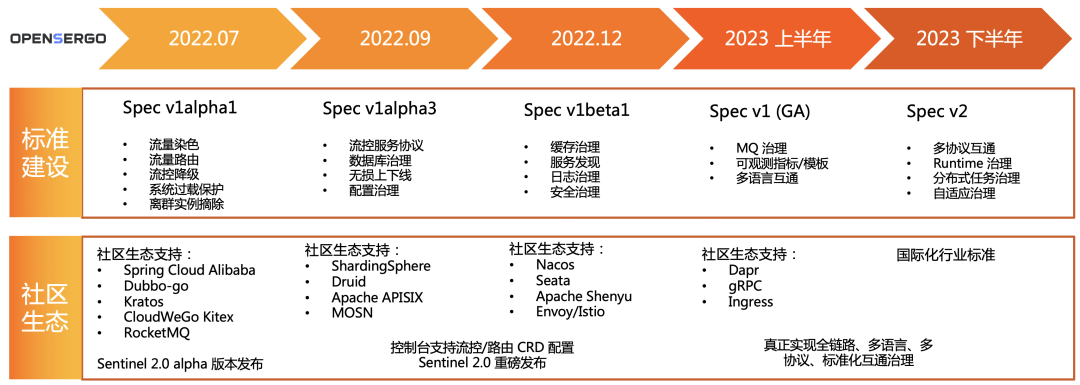
Welcome to join
OpenSergo Since its inception, it is a community project , adopt Apache License 2.0 Open source agreement .OpenSergo Is working with Apache Dubbo, CloudWeGo Kitex ( byte ), Kratos (bilibili), Spring Cloud Alibaba, Apache APISIX Wait for the community to cooperate , Jointly improve the design and implementation of service governance standards , Together OpenSergo spec Promote and implement into more micro service ecosystems . Follow up OpenSergo Formulation of service governance standards 、 On development , Also through public 、 transparent 、 Democratic way to set standards 、 Promote the implementation of . The community also passed GitHub issue、Gitter、 Mailing list, 、 Community biweekly meetings and other mechanisms , Ensure that standards and implementation are jointly built through community collaboration . Welcome to discuss together through these forms 、 To build .
You are also welcome to join us OpenSergo Community nail group , Together, define the future of microservice governance :

At the same time, we also provide OpenSergo Enterprise level products of microservice standard MSE, Provide service governance 、 Flow control degradation 、 Register configuration center 、 Cloud native gateway 、 Core capabilities such as distributed transactions , Welcome to experience .
Related links :
OpenSergo Project website :
OpenSergo spec:
https://github.com/opensergo/opensergo-specification
Alibaba cloud micro service engine MSE,OpenSergo Enterprise level implementation of :
https://www.aliyun.com/product/aliware/mse
MSE First purchase of professional edition of registration configuration center 9 A discount ,MSE Full specification of cloud native gateway prepaid 9 A discount .
Click on
, Enjoy the discount ~
原网站版权声明
本文为[InfoQ]所创,转载请带上原文链接,感谢
https://yzsam.com/2022/188/202207070007211146.html








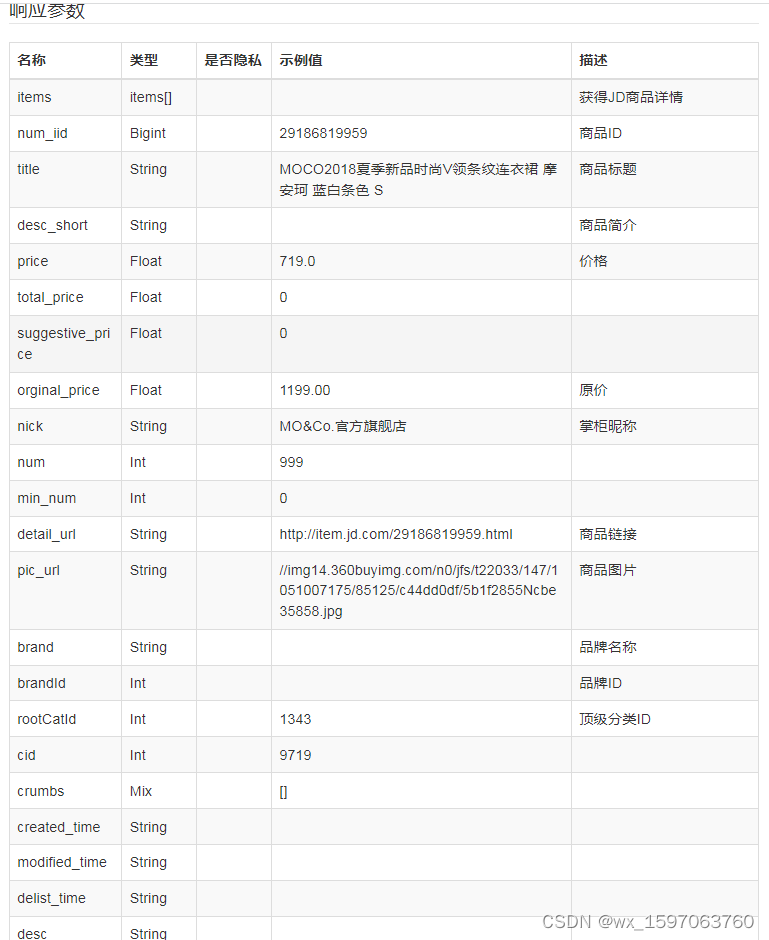


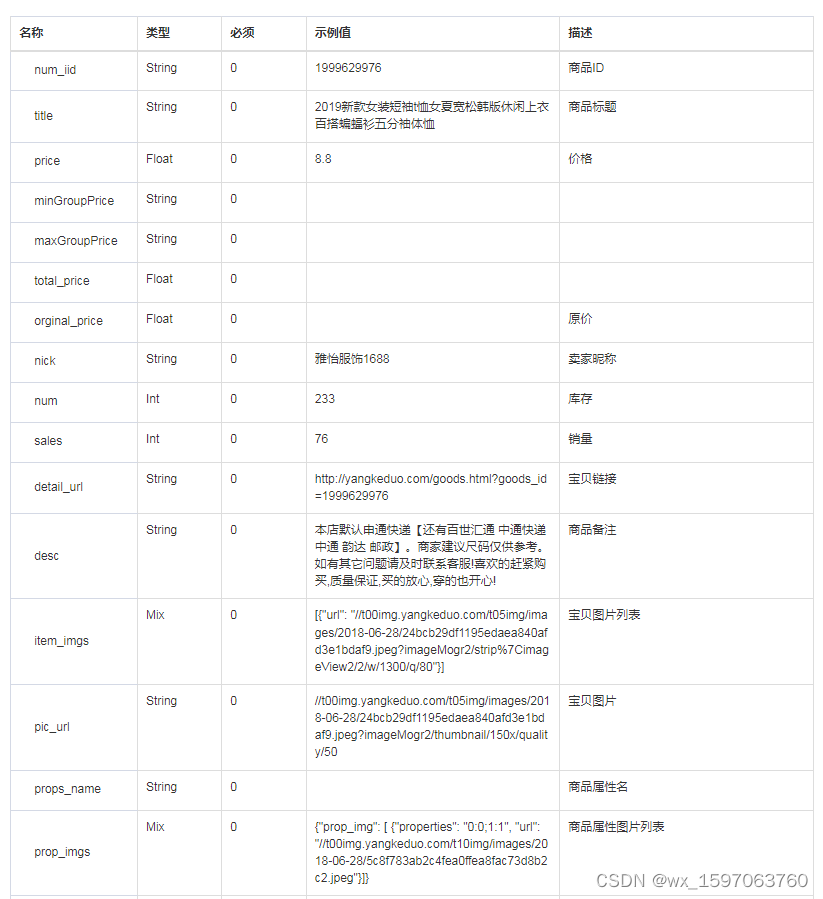
![SQLSTATE[HY000][1130] Host ‘host. docker. internal‘ is not allowed to connect to this MySQL server](/img/05/1e4bdddce1e07f7edd2aeaa59139ab.jpg)
![Paper reading [MM21 pre training for video understanding challenge:video captioning with pre training techniqu]](/img/9c/1f031400f0e201df47bd51547ff73f.png)


